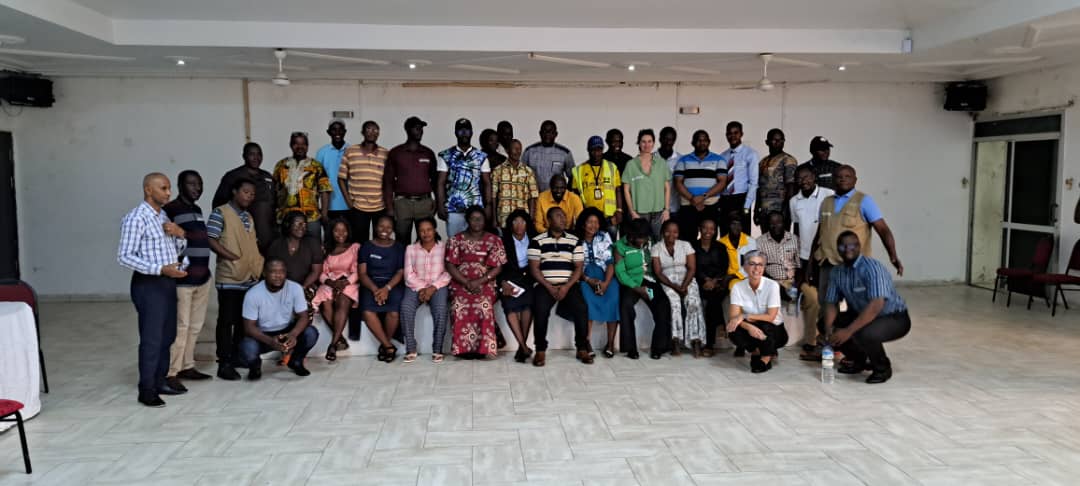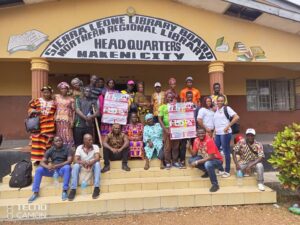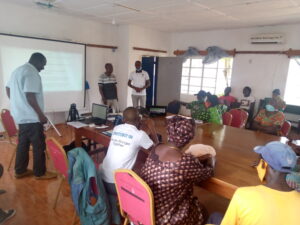It could be recalled in 2023, Green Scenery Sierra Leone, and Land for Life approached one of it development partner, Food and Agricultural Organocation (FAO), for supports to strengthening the existing structures of Districts Multi Stakeholders Platforms (DMSPs), established by Green Scenery and Land for Life, to adequately respond to issues relating to natural resource governance (Land), and other related matters at Districts ,Chiefdoms and Community levels in Sierra Leone. (for more information See website like https://greenscenery.org/faogreen-scenery-and-land-for-life-kick-strat-three-days-stakeholders-engagements-with-district-multi-stakeholders-platform-in-sierra-leone/).
On Thursday , 7 March 2024, at Wusum Hotel, Makeni, Northern part of Sierra Leone, FAO, Green scenery(GS) ,and Land for Life Sierra Leone, concluded a three Days Multi Stakeholders Engagements with the Districts Multi Stakeholders Platforms (DMSP) on Land governance in Sierra Leone, with representatives from six strategic districts :Pujehun, PortLoko, Kenema, Tonkolili ,Bombali, and Kambia districts. The action was supported by food and agriculture organization(FAO) with technical support from GIZ.
The engagements brought together representatives from different sectors(CSOs, CBOs, media, Government Institutions, Academicians, Religious groups, Women’s groups, Youth groups, Persons with disabilities ),discussing wide rage of issues relating to natural resource governance reform(agri-business and Extractive),and developed strategies that will adequately respond to the emerging issues on natural resource governance.
The main objective of the engagements(workshop), is to deepening and strengthening the existing structures of the District Multi-Stakeholder Platform(DMSP), making them more efficient and effective, to address issues relating to natural resource governance(Public policy reforms and implementation on Land governance), social justice, tenure security ,human rights and conflicts related issues on land in Sierra Leone. The engagements further aim at increasing mutual understanding on the works of the DMSPs in six districts, develop governance structures, clearly defined priority issues and objectives , conduct Stakeholders mapping and engagement plans , create a common vision, and develop a short and medium term work plan of the Districts Multi Stakeholders Platforms (DMSPs)in Pujehun, PortLoko, Kenema, Tonkolili ,Bombali, and Kambia districts .
At the begging of sessions, Statements were made by different speakers, followed by an introduction of a dramatize short interview , depicting the conceptual frameworks ,purpose and relevance of the DMSPs work. The interview was actioned by Joseph Rahall, Executive Directors Green Scenery and Bearns Komba Lebbie, National Coordinator Land for Life Sierra Leone, moderated by Jacup Willison ,media expert Land for Life Sierra Leone. The interview gave participants an insights on the purpose, legitimacy, relevance and sustainability of the DMSP.
Given an overview on the conceptual framework and evolution of the Districts Multi stakeholders Platform, the Executive Directors, Green Scenery , Joseph Rahall said, the idea behind the establishments of Green Scenery District Multi-stakeholder platforms (DMSPs), was envisaged in 2020,due to challenges relating to land governance processes ,human rights, social injustice and conflicted related issues on land in Sierra Leone. He said, the DMSP was established to strengthening and complements existing structures on land reform processes, facilitates the establishment of proposed structures as enshrined on the two land laws(Town/Village Area Land Committee, Chiefdom Land Committees and Districts land Committees),leverage synergy, explore opportunities, networking and collaborations, fill in gaps where the need arises and monitoring compliances on the implementation of the Customary Land Rights Act 2022,and the National Land Commission Act 2022(See website on the enactments of the two land laws (https://greenscenery.org/executive-arm-of-government-approved-the-land-bills/ ).
Its a holistic problem solving mechanisms involving different actors and expertise working together as a group, aiming at addressing social issues affecting local peoples. The platform perform an interlocutory functions, serving as an intermediaries between government, powers holders and local citizens aim at addressing wide rage of issues affecting local citizens. The Director further said, the platform bring together different actors with diverse expertise and power influence working together as a group to influence changes at MESO(Districts) and MICRO (Local or Community levels). (For more information on the evolution of Green scenery DMSPs visit the website https: https://greenscenery.org/green-scenery-established-the-district-multi-stakeholders-platform-dmsp-to-improve-the-governance-of-tenure-on-land-in-pujehunport-loko-and-bombali-districts/).
The alternative dispute resolution officer, Legal Aid Board Bombali district (Makeni), gave a rundown on additional relevance of the DMSPs .She said, the establishments of DMSP is relevance because it creates the platform where different actors with diverse powers and expertise interacts together as a group to influence change on issues affecting local peoples, primarily issues relating to boundary and family land conflicts , conflicts between harder’s and farmer, genders’ discriminations, social injustice , power imbalance, poverty, environmental protection and climate change, capacity building , and monitoring the implementations and compliances of the new land laws (Customary Land Rights Act 2022,and the National Land Commission 2022)(see the enactment of new land laws https://greenscenery.org/executive-arm-of-government-approved-the-land-bills/)
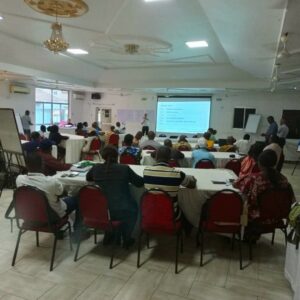 Francesca from FAO and Dr .Tunis from GIZ, are the lead facilitators on the three days engagements .After the introduction of the agenda , the facilitators too participants through the following thematic areas : Who are we(DMSP)and Why do we want to work in DMSPs?, Who are the Stakeholders in the DMSP ? who is there now as a stakeholder and who is not there that relevant to the DMSP work? Building a common vision of all DMSPs, Identify the DMSP priority issues, DMSP governance structure, develop work plan, Define DMSP priority objectives, Stakeholder analysis and Sustainability plan, legitimacy and formalization of the DMSP.
Francesca from FAO and Dr .Tunis from GIZ, are the lead facilitators on the three days engagements .After the introduction of the agenda , the facilitators too participants through the following thematic areas : Who are we(DMSP)and Why do we want to work in DMSPs?, Who are the Stakeholders in the DMSP ? who is there now as a stakeholder and who is not there that relevant to the DMSP work? Building a common vision of all DMSPs, Identify the DMSP priority issues, DMSP governance structure, develop work plan, Define DMSP priority objectives, Stakeholder analysis and Sustainability plan, legitimacy and formalization of the DMSP.
DEFINED DMSP IN A BROADER CONTEXT: 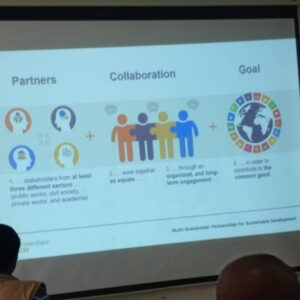 The facilitators defined DMSP; as a platform or partnership that comprises of at least three different sectors (Public sector, Civil Society, Private Sector and academic), working together as equals, through an organized platform and a long term engagement in order to contributes to the common good. The facilitators further took the participants through a plenary on, why working with the DMSP. After series of deliberations through plenary , it was agree that ,the DMSP perform the following functions and relevance:
The facilitators defined DMSP; as a platform or partnership that comprises of at least three different sectors (Public sector, Civil Society, Private Sector and academic), working together as equals, through an organized platform and a long term engagement in order to contributes to the common good. The facilitators further took the participants through a plenary on, why working with the DMSP. After series of deliberations through plenary , it was agree that ,the DMSP perform the following functions and relevance:
- Mediates and Resolve land conflicts issues at all levels
- Its an inclusive platform that captures the views and opinions of every body and work collectively to address land governance issues
- A platform that settles land disputes out of court through alternative disputes resolutions mechanisms.
- A space that provides capacity building through learning and experience shearing to leverage opportunities to addresses land governance issues that undermines peace, stability and social cohesion,
- Its facilitates the recognition, promotion and protection of women’s rights to access, ownership and control over land.
- It a problem solving platform that put together different perspectives, and collaborates with different actors on land governance issues.
IDENTIFIED SATKEHOLDERS THAT ARE RELAVEANT TO THE DMSP WORK: 
In identifying stakeholders that are relevant to the DMSP platform, participants were divided into groups, per districts, each group, mapped and analysis their existing stakeholders ,including their powers, influences and relevance to the work of the DMSPs. After through deliberations through plenary, the following stakeholders shared commonalities to the DMSPs work in the six districts.
- Government Representatives/MDAs
- Traditional Authorities/leaders
- Media institutions,
- Civil Society Organizations(CSOs)
- Community Representatives
- Religious groups
- Private companies (agric- companies)
- Persons with disabilities .
- Youth groups and
- Women’s group
- Academicians
At the end, Stakeholders that are relevant to the DMSPs work were mapped and powers analyzed and plans were developed to bring in stakeholders that are relevant to the DMSPs work.
GOVERNANCE STRUCTURE OF THE DMSP:  For DMSP to be efficient and effective in carrying out it mandates, there is the need for a body machinery, Governance frameworks or structure in nature, that delineates interrelated relationships and communication between and among different powers. Hence, the facilitators presented a proposed DMSP governance structure, which they asked DMSP members in the six districts to examine and see , if applicable in their context. There were no concessive conclusion at the end, as to whether the proposed governance structure presented could be used or not. The governance structure presented was not finalized and adopted.
For DMSP to be efficient and effective in carrying out it mandates, there is the need for a body machinery, Governance frameworks or structure in nature, that delineates interrelated relationships and communication between and among different powers. Hence, the facilitators presented a proposed DMSP governance structure, which they asked DMSP members in the six districts to examine and see , if applicable in their context. There were no concessive conclusion at the end, as to whether the proposed governance structure presented could be used or not. The governance structure presented was not finalized and adopted.
COMMON VISION OF THE DMSP: 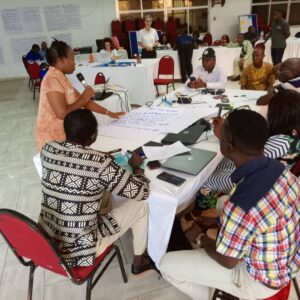 After series of deliberations, the DMSP vision was tentatively agreed to be : “To create an inclusive, peaceful, sustainable future through effective land governance, where youths are empowered with opportunities for meaningful participations, whiles holding ourselves accountable for justice and environmental stewardship ,hence Women’s land rights are central to our work”. The proposed vison was subjected to scrutiny due to incompatibility, complexity and incomprehensiveness. The vision was not finalized and adopted due to been elaborates and lacks key elements. The facilitators therefore, asked the institutional heads (Green Scenery and Land for Life), to work with DMSPs member in the six districts as a follow up actions, to frame and finalized the DMSPs common vision within the shortest possible time, as FAO and GIZ experts will do a follow up to assert DMSP progress in months.
After series of deliberations, the DMSP vision was tentatively agreed to be : “To create an inclusive, peaceful, sustainable future through effective land governance, where youths are empowered with opportunities for meaningful participations, whiles holding ourselves accountable for justice and environmental stewardship ,hence Women’s land rights are central to our work”. The proposed vison was subjected to scrutiny due to incompatibility, complexity and incomprehensiveness. The vision was not finalized and adopted due to been elaborates and lacks key elements. The facilitators therefore, asked the institutional heads (Green Scenery and Land for Life), to work with DMSPs member in the six districts as a follow up actions, to frame and finalized the DMSPs common vision within the shortest possible time, as FAO and GIZ experts will do a follow up to assert DMSP progress in months.
PRIORITIES OBJECTIVES OF THE DISTRCITS MULTI STAKEHOLDERS PLATFORM:  The Districts Multi-stakeholders Platform (DMSP), response to diverse and emerging issues affecting societies at local levels. The lead facilitator asked DMSP members to identify priorities issues and objectives. After series of deliberations and discussions, Priorities issues were identified , hence formulated to priority objectives. The six priorities issues or objectives identified by DMSP members in six districts are:
The Districts Multi-stakeholders Platform (DMSP), response to diverse and emerging issues affecting societies at local levels. The lead facilitator asked DMSP members to identify priorities issues and objectives. After series of deliberations and discussions, Priorities issues were identified , hence formulated to priority objectives. The six priorities issues or objectives identified by DMSP members in six districts are:
- Establishments and strengthening Local Structures
- Conflict Resolution approach through alternative dispute resolution processes
- Community Legal Empowerments through awareness razing on the two land laws and other legal frameworks,
- promote access and control of land by women and vulnerable groups.
- Climate Change and environmental protection
- community led agriculture for food security
Objective one(1) to objective four(4) are the priority issues that are common or cut across the six districts. The latter’s (5-6) objectives are not common, but categories as complementary to objective (1 -4)
THE WORK PLAN OF THE DISTRICTS MULTINSTAKEHOLDERS PLATFORM(DMSP):  The facilitators put DMSPs member into groups , per district, and asked groups members to develop work plans based on priority issues identified and objective formulated. At the end, tentative District work plans were developed, but not thoroughly dealt with due to limited time. The facilitators asked DMSPs members to develop final work plans upon their returns to their respective districts, which could be possibly used in the DMSPs proposal development.
The facilitators put DMSPs member into groups , per district, and asked groups members to develop work plans based on priority issues identified and objective formulated. At the end, tentative District work plans were developed, but not thoroughly dealt with due to limited time. The facilitators asked DMSPs members to develop final work plans upon their returns to their respective districts, which could be possibly used in the DMSPs proposal development.
At the end of the three days engagement ,participants were able to broaden and deepening their knowledge on what DMSP is all about, platform purpose and relevance , conducted stakeholders mapping, analysis and identified stakeholders that are relevant to the platform works, identified priority issues , define priorities objectives, bulled a proposed common vision, developed proposed work plans, conducted stakeholders analysis and sustainability pathway .
Going forward, the actions below are the decision reached, after the three days engagements. The decisions reached requires follow up actions by the lead institutions(Green Scenery and Land for Life) in the six districts.
- Review and finalize priority issues and objectives
- Examine and finalized DMSP Work plan per District
- Re -examination and Adoption of DMSP common vision
- Conducts stakeholders mapping
- Review existing and identify potential stakeholders that are relevant to DMSP work at district levels
- Developed DMSP governance structure and
- Sustainability plan,
- Facilitates the establsument of a national Watsap forum
- Assess the feedbacks from the DMSPs meetings at district level as agree upon to relay discussions and agreed actions on the three days engagement.
- Developed and sign MOU between Partners organizations and DMSPs members at district levels.
Participants appraised and characterized the three days engagements as laudable, efficient and effective. They thank FAO, GIZ, Green Scenery and Land for Life for the initiative which they describe as laudable and timely.
NOTE:
FOR MORE INFORMATION CONTACT GRREN SCENETY@
POX 278
42 Charles Street, Freetown, Sierra Leone, West Africa.
land :+23222220400
Mobil:+23276601979
Email:greenscenery@gmail.com
Website:www.greenscenery.org
Facebook page:#SLGeenscenery
